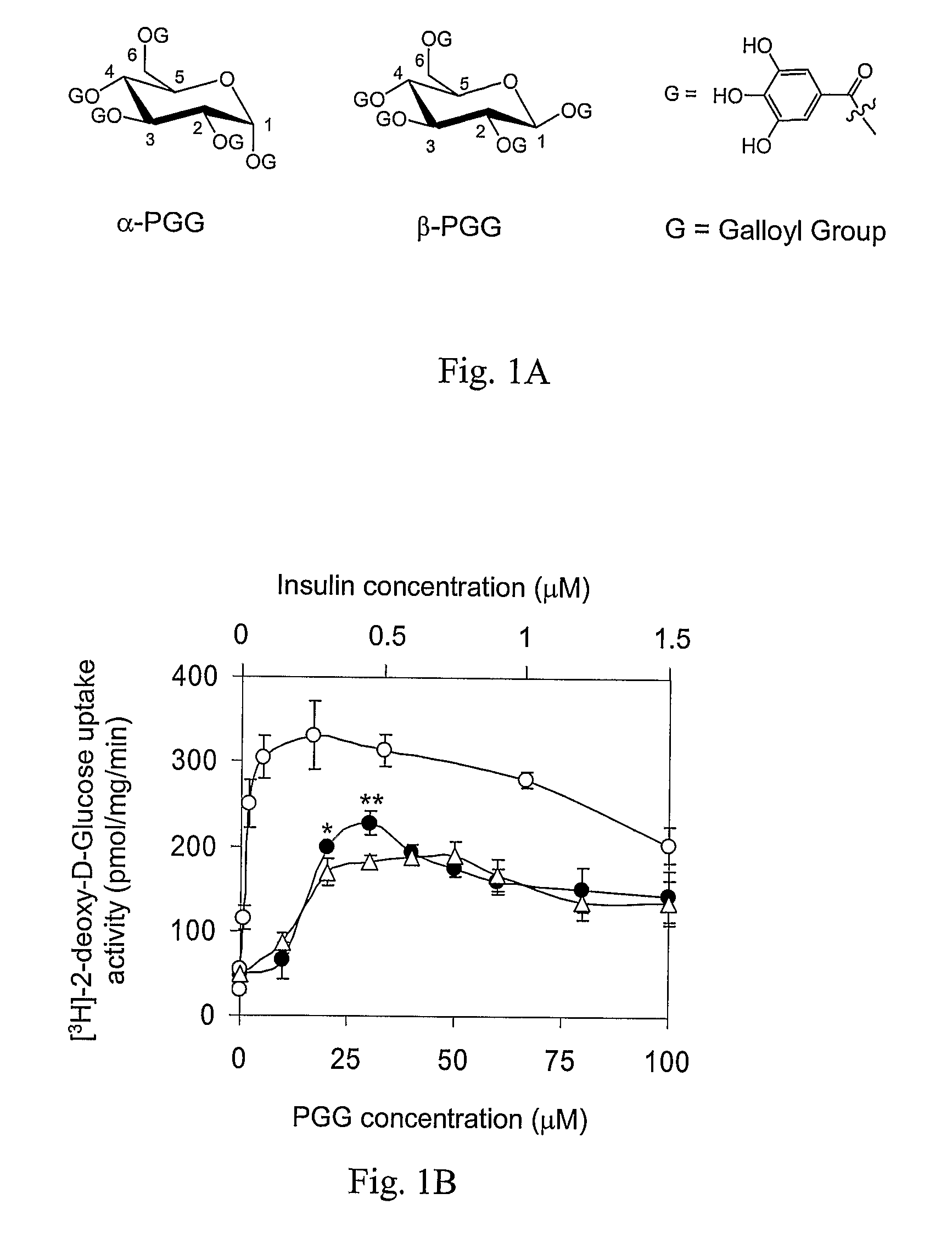Methods and systems for identifying insulin mimetics
a technology of insulin mimetics and methods, applied in the field of methods and systems for identifying insulin mimetics, can solve the problems of impaired glucose tolerance, uncontrollable hyperglycemia, increased and premature mortality,
- Summary
- Abstract
- Description
- Claims
- Application Information
AI Technical Summary
Benefits of technology
Problems solved by technology
Method used
Image
Examples
example 1
α- and β-PGG Stimulate Glucose Transport in 3T3-L1 Adipocytes
[0046]The approximately equimolar mixture of α- and β-PGG (22, FIG. 1A) was synthesized. The compounds were chromatographically separated, and tested individually. α-PGG and β-PGG induced glucose transport in adipocytes in a dose-dependent manner (FIG. 1B). At the 15-30 μM concentration range, α-PGG was consistently 10-20% more active than β-PGG (FIG. 1B, P<0.05 at 15 μM, and P<0.01 at 30 μM). The difference in activity may be accounted for by the structural differences around the anomeric carbon (carbon-1) of the glucose core of the molecules (FIG. 1A). The estimated EC50 for glucose transport activity for α-PGG was 13 μM±2 μM. Since α-PGG showed a higher activity than the β-anomer, it was chosen as our lead compound for the following studies. Addition of α-PGG to insulin reduced the glucose transport activity induced by insulin towards that of α-PGG (FIG. 1C). This result indicates that α-PGG-induced glucose transport ac...
example 2
α-PGG Activates Protein Factors Involved in the Insulin-Mediated Glucose Transport Signaling Pathway
[0047]Molecular and cellular studies were initiated to test the hypothesis that PGG activates the insulin-mediated glucose transport signaling pathway. The glucose transport activity induced by α-PGG in adipocytes was completely abolished in the presence of the insulin pathway inhibitors HNMPA-(AM)3, wortmannin, or cytochalasin B (FIG. 2A). Importantly, HNMPA-(AM)3, which inhibits the tyrosine kinase of IR, also completely blocked the activity of α-PGG (FIG. 2A). This result suggests that the target of α-PGG's glucose transport induction is IR, not protein factors downstream from IR. Protein studies revealed that α-PGG induces the phosphorylation of the IR (FIG. 2B) and activates PI-3 kinase (FIG. 2C) in CHO-IR cells, which express significantly more IR than 3T3-L1 adipocytes. It was further shown that Akt was phosphorylated in 3T3-L1 adipocytes in a dose-dependent fashion (FIG. 2B). ...
example 3
α-PGG Binds to Insulin Receptor and Affects Insulin-IR Binding
[0048]SPR study results indicate that α-PGG binds to pure IR with an apparent binding affinity (Kd) of 43±2 μM (FIG. 3A). Together with the findings that α-PGG stimulates insulin-like glucose transport activity (FIG. 1B) and activates protein factors, including IR, involved in the insulin-mediated glucose transport signaling pathway in adipocytes (FIG. 2), this result further supports that the target of α-PGG's glucose transport induction in adipocytes is the IR. The maximal binding (Bmax) for insulin was reduced in a dose-dependent manner with increasing amounts of α-PGG without significantly affecting the Kd (FIG. 3B). This result indicates that α-PGG affected the total binding of insulin without altering insulin's binding affinity to the IR. α-PGG did not bind to insulin, and the inhibitory effect on insulin binding was not a result of α-PGG-insulin binding.
[0049]The notion that α-PGG affects insulin-IR binding was fur...
PUM
| Property | Measurement | Unit |
|---|---|---|
| volume | aaaaa | aaaaa |
| pH | aaaaa | aaaaa |
| pH | aaaaa | aaaaa |
Abstract
Description
Claims
Application Information
 Login to View More
Login to View More - R&D
- Intellectual Property
- Life Sciences
- Materials
- Tech Scout
- Unparalleled Data Quality
- Higher Quality Content
- 60% Fewer Hallucinations
Browse by: Latest US Patents, China's latest patents, Technical Efficacy Thesaurus, Application Domain, Technology Topic, Popular Technical Reports.
© 2025 PatSnap. All rights reserved.Legal|Privacy policy|Modern Slavery Act Transparency Statement|Sitemap|About US| Contact US: help@patsnap.com



